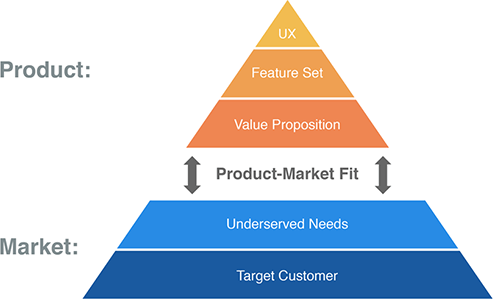

A product-market fit describes a scenario in which a company’s target customers are buying, using, and telling others about the company’s product in numbers large enough to sustain that product’s growth and profitability. The company must have validated its value proposition for consumers before starting its expansion efforts.
According to entrepreneur and investor Marc Andreesen, who is often credited with developing the concept, product-market fit means finding a good market with a product capable of satisfying that market. Product-market fit is what allows a company to either jump into new markets or continue in its current business model by having a "complete" product offering that wins over customers.

Product-market fit is the point at which your customers love using and continuing to use your product. In other words, it means that once they’re using it, they want to continue using it. But achieving product-market fit is not necessarily easy — you need to make sure that your product is one that people are excited about using.
A product with PMF is a great way to foster customer loyalty, especially in the early stages. With a declining curve and high churn, users are likely to leave because they don’t see the value of staying on the product. The smiling curve, however, indicates that there are enough users who enjoy working with your product and continuously return. The flattening curve is also important: once you have crafted an offering that works well for your customers, it’s important for them to stick around for long-term value instead of being motivated by short-term sales numbers.
To prove product-market fit, you need to be able to demonstrate that your customers would be disappointed if you stopped making a product. Sean Ellis calls this the “hardest thing for a company to make growth happen.” So how can you measure it? Word of mouth is one way — explain to friends why you’re successful, and ask them how your product compares with competitors; if 40% say they would be very disappointed without it, that’s a sign of product-market fit.
Word of mouth is a powerful tool, so make it a point to reward your early customers and support. When they refer others, you can use referral links and codes to track where new customers are coming from. Create referral cards with a code or a link that calls out their score, to incentivize customer loyalty. If a customer receives an offer for more storage or an extended service guarantee with every purchase, encourage them to share the offer with friends — especially those with high NPS scores.
Startups are often faced with the challenge of finding out if they’ve hit product-market fit. But Andrew Chen, a venture capitalist and entrepreneur, says there’s no single set of metrics that can tell them when they’ve achieved their goal. Instead, he offers some signals that a company is heading in the right direction with its offering.
When designing your product, determine whether or not users would be willing to switch to it. This decision has implications for the competitive landscape and efforts to build a sustainable business.
In fact, data from user testing will provide insight into how people perceive your product and how that perception correlates with their willingness to adopt it.
Measurements such as these will provide useful data about how customers view the product. It also gives you a chance to see whether or not your customers are experiencing the problem you set out to solve, and how long it is taking them to get there. Word of mouth is a powerful marketing tool. When customers tell other customers about their positive experiences with your product, you’re increasing exposure for your brand in a very effective way. With word-of-mouth consistently driving demand and growth, this is one of the most encouraging results from your business.
Utilise market research technique to measure and evaluate your product market fit:
Basically, if the market research address those key questions, you can define whether your product is market fit or not.
If your product is strong enough to make the customers can't stay without it, this mean you have product market fit.
Step one is to determine your target customer. What are your ideal customers with whom you would like to make a sale? Identify underserved needs of that customer. What does our product do for them that their current solution doesn’t? Define our value proposition—what value do we provide to them over and above what they can get elsewhere? Specify your minimum viable product feature set—the first version of your product that addresses the most important need it solves. You want a simple, low-risk way of testing whether or not your idea is worth pursuing further. Developing the MVP might involve writing some code, doing some user research, or creating a high-fidelity mockup of how a screen might look.
Measurement is a critical component of any business. It lets you know where your product, service, or idea is being consumed by users and gives you enough information to make necessary changes. Metrics vary depending on the type of business you're in, but are typically created using data from your users, marketing campaigns, and analytics. Use Andrew Chen's suggestions (and others!) to assist in this process for your project!
How do you find product-market fit?
To find product-market fit, you need to have a clear idea of your customers and their motivations. You have to know where they are currently and what they are looking for, then research your competitors. Based on your findings, create a product roadmap, define KPIs and marketing channels that will drive results. This is where product-market fit comes in; it provides clarity within the market and allows you to be flexible alongside your business goals.
Most entrepreneurs set up their business with a vision and then worry about the details later. But how do you know if your idea is working? Many founders neglect listening to feedback, emerging market dynamics and product-market fit—building a business that doesn’t clearly align with the desires of a consumer base.
A product with existing customers will have high usage. In the case of product-market fit, this is because of low entry barriers (don't have to make a purchase) and high barrier to exit (don't want to leave). In your case, you would be able to test whether you have product-market fit by asking customers if they are returning to your product or not after a certain period of time. If they are, then you've found some good feedback on how well it works in practice - if so congrats! But if not - that's not a very good sign for the product and should be something that needs fixing. Also try asking why; if your answer is "cuz I love it" then maybe you don't yet know what people are saying about it - ask them outright instead.
Conduct the market research survey with your customers today, to gain insight and define your product market fit.
The questionnaire to measure product market fit includes:
Part 1: Customer profile
Part 2: Customer pain points and validation
Part 3: Concept test
Part 4: Willingness to purchase / use in future and why.
Check out our website and start asking your customer now.
----------------------------------------
ASHAVI – Boost Business By Insights and Technologies